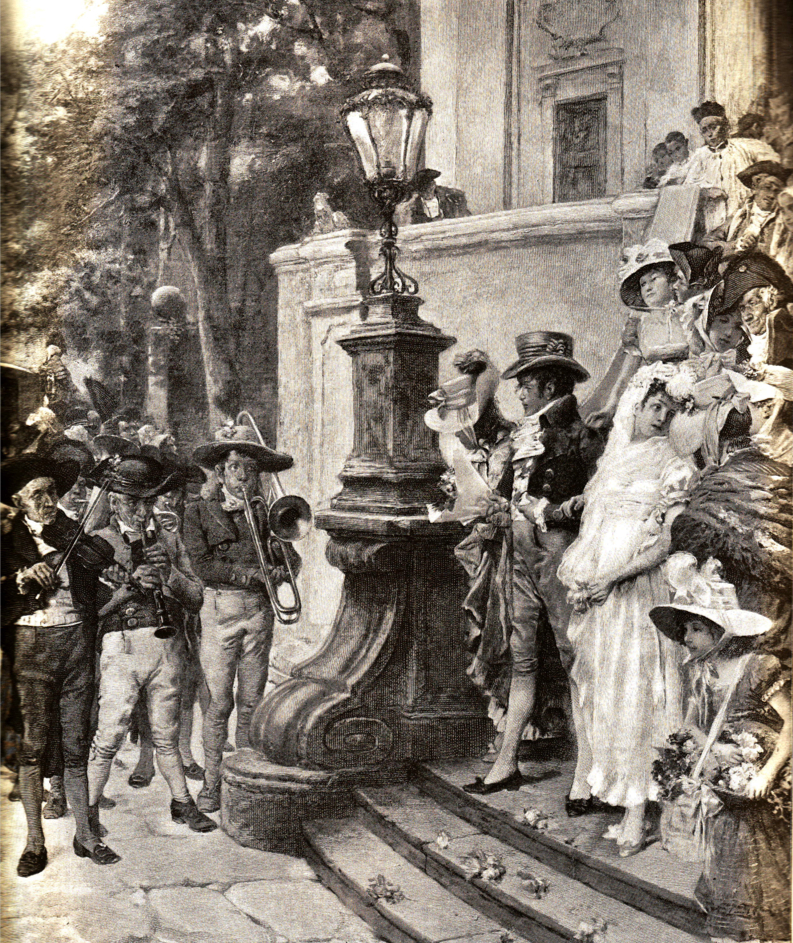Today I added a painting by 19th century Italian artist Angelo Inganni to the Trombone History Timeline (19th century, 2nd half). It features a trombone playing in a small instrumental ensemble for an outdoor wedding celebration. You can also view the image in the collection below, at 1873.
If you’re an active trombonist now, you have likely played your share of wedding gigs. Trombones have been used for important celebrations like weddings from the beginnings of the instrument in the 15th century, continuing to the present. Enjoy the collection below, drawn from the full Trombone History Timeline, of all of the entries involving trombone and weddings/marriages.
_______________
c. 1450—Naples, Italy: The court ensemble includes 3 shawms and a trombone. It performs at weddings, banquets, public and civic ceremonies, in the church, and even on the battlefield (Atlas, Music 110).
1468—Bruges, Belgium: At the wedding of Charles the Bold, duke of Burgundy, to Princess Margaret of England, a wind band consisting of trombones, shawms, and bombards performs a motet and chanson to “excellent effect” (Whitwell, Before 1500 235). At the wedding banquet, numerous instrumentalists perform in costume as animals, the trombonist playing the part of a he-goat (Cazeaux 68).
1479—Leipzig, Germany: A civic wind band is established. Comprised of Master Hans Nagel and his two “sons” (possibly apprentices), their instruments are trumpet, cornett, and trombone. They are paid a yearly wage and supplied with uniforms. They play primarily for public ceremonies and weddings (for which they have a monopoly) (Terry 14).
1487—Bologna, Italy: The wedding of Lucrezia, daughter of Duke Ercole of Ferrara to Annibale Bentivoglio, includes a wind ensemble of “100 trombita e 70 pifari e trombuni e chorni e flauti e tamburini e zamamele” (Whitwell, Before 203).
1500—Torgau, Germany: At the wedding festivities of John the Steadfast (Duke Johann) to Sofia of Mecklenburg, Adam von Fulda directs 2 Masses in the castle chapel, accompanied by organ, 3 trombones (dreyer posaun), a cornett, and 4 crumhorns (Reese 655; Boydell, The Crumhorn 16).
1518—Berlin, Germany: At the Brandenburg court, wedding festivities of the Margrave Casimir of Brandenburg and Dorothea Pfalzgrafin bei Rhein include a band of trombones and cornetts (Whitwell, Renaissance 115).
1529—Ferrara, Italy: Music is played at the court on 5 trombones and a cornett during the 5th course of a wedding banquet. Music during the 7th course includes a trombone (uno trombone), 2 dolzaine, one storta, and one cornetto grosso. During the 8th course, music is played on a trombone (uno trombone), 5 viols, one strumento di penna, a flauto grosso, a lira, and a flauto d’Alemana (Reese 546; Boydell, Crumhorn 37, 389). About the Cena di Pesce(Banquet of Fish), the records states, “And as this course was on the table, a dolzaina, a trombone [uno trombone], and a flute played…a dolzaina, a great bass viol, two cornamuse and a cittern” (Boydell, Cornamuse 389, 416).
1538—Germany: Heinrich Aldegrever portrays a trio of trombone and 2 trumpets in a woodcut titled The Brass Players (Die Posaunisten) from the series The Great Wedding Dances (see facing image; public domain) (Duffin, Trompette des Menestrels).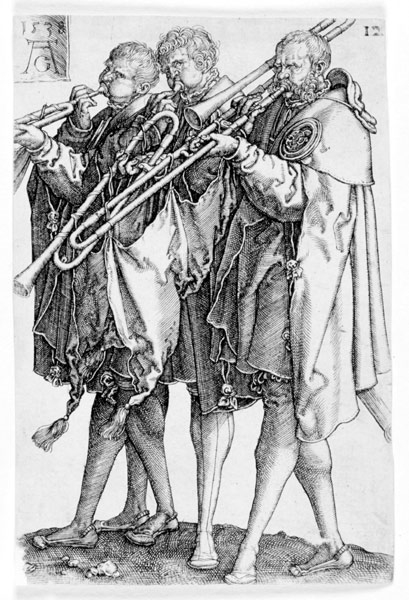
1539—Florence, Italy: “On the entrance of the most illustrious Duchess” at the wedding procession of Duke Cosimo I and Leonora of Toledo, Corteccia’s motet, a 8, Ingredere felicissimis auspiciis urbem tuam Helionora, is “sung over the archway of the great door of the Porta al Prato with 24 voices on one side and on the other 4 trombones and 4 cornetti” (Brown Sixteenth-Century Instrumentation, 88; Reese 366). The wedding festivities also include a madrigal performed by a female vocalist and 4 trombones; a contemporary account records, “This last act was closed by Night, dressed in a black silk veil with a blue-starred headdress, the moon above her forehead….She sang sweetly Ventien ’ almo riposo: ecco ch ’ io torno to the accompaniment of 4 trombones (Bowles, Musical Ensembles 25). In addition, at the wedding banquet in a courtyard of the Palazzo Medici, the 9 muses sing Francesco Corteccia’s motet, a 9, Sacro e santo Hymeneo. Although the muses are not described as playing instruments, they each hold one; a contemporary accound mentions, “The first [Thalia] was in a very blonde cloth, girded with a green olive branch…a trombone [trombone] in her right hand” (Brown, Sixteenth-Century Instrumentation 88; Bowles, Musical Ensembles 24; Boydell, Crumhorn 41).
1548—Germany: A tapestry depicting a wedding dance features an ensemble of 2 trumpets and a trombone playing from a balcony (see below image; public domain) (Schlossmuseum, Berlin [now lost]; Führer lurch das Schlossmuseum, pl. 30).
1549—Munich, Germany: Outdoor Feast, a painting by Hans Mielich (Müelich), court painter for Duke Albrecht V, depicts an outdoor wedding banquet. The music ensemble includes 2 trombone players, one of whom appears to have multiple instruments in his hands and is apparently in the act of switching from one trombone to another. The painting also shows, in a different area, a dance band consisting of 2 trombones and another instrument (probably a shawm) (see detail and full image below; public domain image) (Kenton plate 14; Buchner plate 95).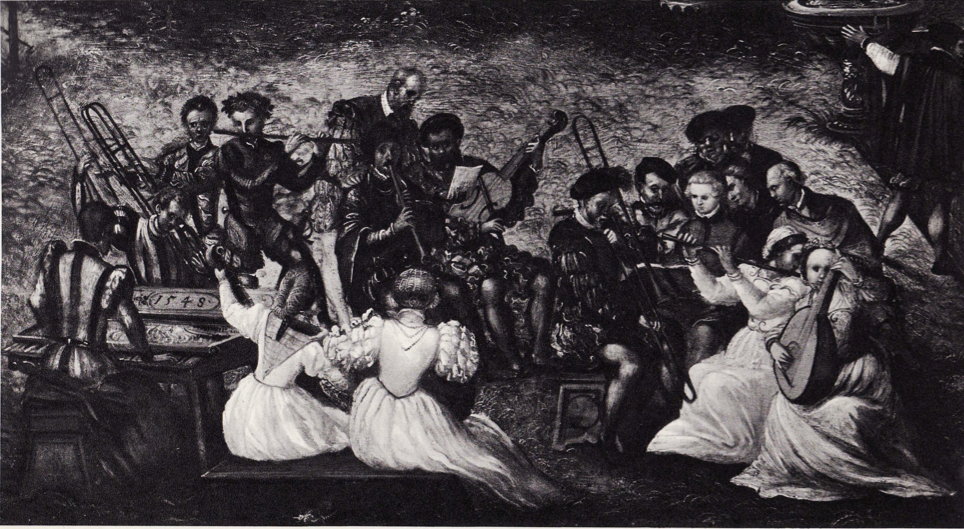
1565—Florence, Italy: Wedding festivities for Prince Francesco de’ Medici and Johanna of Austria include performance of the comedy La Cofanaria by Francesco d’Ambra, with interludes (intermedii) between the acts. The trombone is used in several different settings. The 1st intermedio, for example, calls for 2 trombones (Westrup, Monteverdi and the Orchestra), and the 5th intermedio features Striggio’s madrigal Fuggi mia speme, fuggi, accompanied by 4 violins and 4 offstage trombones (Bowles, Musical Ensembles 53). Duke Ferdinand of Bavaria, a guest at the wedding, writes in a letter that wind music is also performed at the wedding breakfast: “at the breakfast…music was played with cornetts, trombones [pusaunen], also with crumhorns; but they only played Italian dances which in my opinion were nothing special” (Boydell, Crumhorn 53).
1566—Florence, Italy: Wedding festivities for Prince Francesco de’ Medici and Johanna of Austria include an allegorical procession, Genealogy of the Gods, in which one of the 9 muses “marche[s] in elegant fashion” with a trombone (Bowles, Musical Ensembles 54).
1568—Florence, Italy: Wedding celebrations for the marriage of Virginia de’ Medici to Cesare d’Este include intermedii for the comedy L’Amico fide, by Giovanni Bardi. Music for the intermedii is by Bardi and Alessandro Striggio. In the 2nd intermedio, a “horrible old man with a scraggly beard, naked and covered with flames,” sings to the accompaniment of trombones and bass viols. In the 3rd intermedio, birds signaling the arrival of spring are accompanied by lutes, harps, muted cornets, trombones, and dulcians. In the 4th intermedio, an angry Neptune sings to the accompaniment of trombones, lutes, harps, and transverse flutes (Nagler, Theatre Festivals of the Medici 58-65).
1568—Munich, Germany: During a banquet celebrating the marriage of Wilhelm V of Bavaria to Renata (Reneé) of Lorraine, trombone participates in numerous pieces: Musicians play Battaglia a 8 of Annibale Padovano on trombones and cornetts, then a 7-voice motet by Lassus with 5 cornetts and 2 trombones, followed by a madrigal by Alessandro Striggio for 6 bass trombones (one of which plays an octave lower than usual). During another course, 5 trombones and a cornett participate in works by organist Annibale Padovano and “other masters” (Haar, Munich 251, 253; Bowles, Musical Ensembles 60). At least 3 other banquet performances include trombone. One of them features, according to eyewitness Massimo Troiano, “the wind instruments, now with cornamuse, now with recorders, now with flutes, and now with trombones [tromboni] and cornetts” (Boydell, Crumhorn 295). In another banquet, “…here there played sweetly a harpsichord, a trombone [trombone], a recorder, a lute, a cornamusa, a mute cornett, a viola da Gamba, and a flute, which music certainly pleased me greatly” (Boydell, Crumhorn 295). During the “fruit course” of the final banquet of the celebrations, a 24-part work is performed that includes “Eight viole, eight viole da braccio, and eight different instruments, namely a curtal, a cornamusa, a mute cornett, an alto cornett, a large twisted cornett, a fiffaro, a dolzaina, and a large trombone [un Trombone, Grosso]” (Boydell, Crumhorn 296). The performance is followed by a vocal version of the same piece by the members of the ducal chapel (Haar, Munich 254). According to Reese, Alessandro Striggio’s 40-part motet, Ecce beatam lucen, is performed at the celebrations, utilizing a mixed consort of 8 trombones, 8 viols, 8 recorders, 2 choirs of 8 voices, a bass lute, and a harpsichord (Reese, 487).
1575—Stuttgart, Germany: According to a poetic account of the marriage festival of Duke Ludwig von Württemberg and Dorothea Ursula, “There went a long procession / Of princes, counts and lords, / And there was a throng of nobles / On all sides in the hall, / Who approached here and there, / To view the princely dance. / The women also came there as well / In a long line, two-by-two….Then a sound was heard above the throng. / Trumpets and trombones blew, / And the kettledrums boomed mightily, / This (as I have heard truly tell) / There was no place in the entire city / Where [the music] could not be clearly heard” (Bowles, Musical Ensembles 61). Trombone is also mentioned in descriptions of other wedding festivities: “When [the noble guests] reached the castle / then things really got started… / In every corridor, at every corner / The instruments were heard / with music sweet as angels, / With charming sound and tone, / In artful harmony all. / And rich-sounding ensemble / of trombones [Pusaunen], loud cornetts…” During the wedding ceremony itself, “Therein the choir was heard / Singing freely with eight voices… / Thus the nuptial song resounded / With trombones and singing…” (Bowles, Musical Ensembles 103; Boydell, Crumhorn 328).
1580—Innsbruck, Austria: A procession to a tournament that is part of marriage celebrations of Johann Lipsteinsky von Kolowrat and Katharina von Boymont und Pairsberg includes a trio of dulzian and 2 trombones (see facing image; public domain) (Bowles, Musical Ensembles 85, 89).
1581—France: Music for the Ballet Comique de la Reyne, written for the marriage of the sister of the Queen of France, contains an overture, now lost, that calls for “hautboyes, cornets, saquebuttes and other soft instruments” (Herbert, Trombone 100; Westrup, Monteverdi and the Orchestra).
1582—Dresden, Germany: In a procession celebrating the marriage of Christian I of Saxony, a symbolic entourage of Bacchus includes a quartet of 2 trombones, cornett, and tenor shawm (see below image; public domain) (Bowles 103-4). In the final tableau, a trombonist, one of 5 instrumentalists attired as angels, stands on a fire-breathing dragon, announcing the Last Judgment with his trombone (Bowles, Musical Ensembles 103).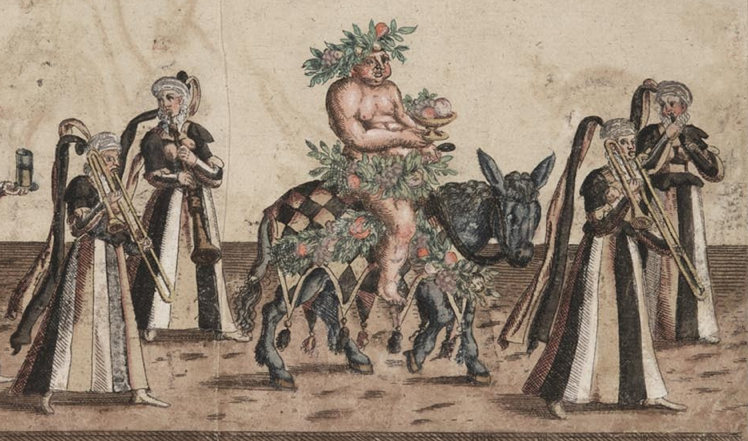
1582—Dresden, Germany: A festival book recording the details of a procession celebrating the marriage of Christian I of Saxony shows a group of 8 female musicians, the last of whom is playing a trombone (see below image, click for larger version; public domain).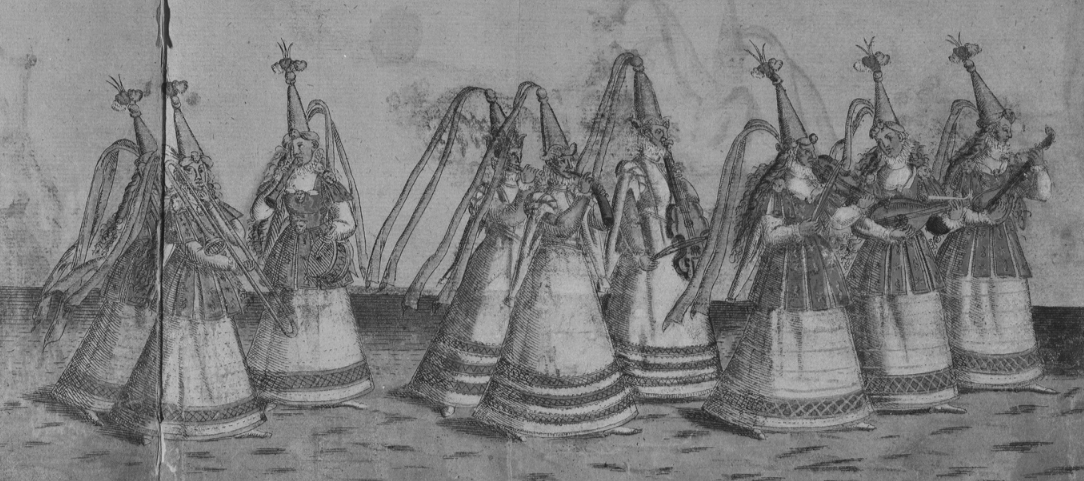
1582—Dresden, Germany: A festival book recording a procession celebrating the marriage of Christian I of Saxony (see also 2 entries above) shows a group of musicians on a festival wagon, including a trombonist playing the instrument in a very vertical position (see below image, click for larger version; public domain).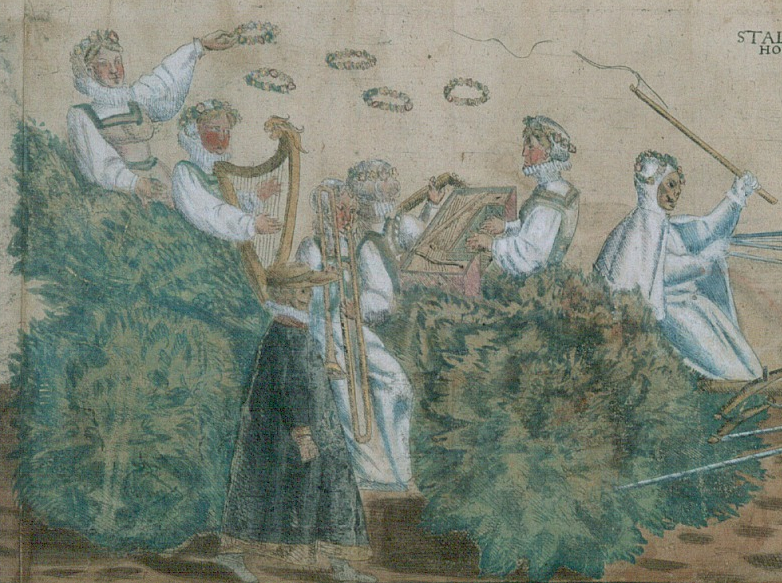
1584—Dresden, Germany: A procession during wedding festivities for Balthasar Wurm and Anton von Sahlhausen at the court of Saxony, includes 8 musicians dressed as women, playing trombone, lute, cittern, treble viol, bass recorder, tenor viol, transverse flute, and clavichord; a graphic representation of the procession shows the trombone at the head of the group (see below image; public domain) (Bowles, Musical Ensembles 105, 107).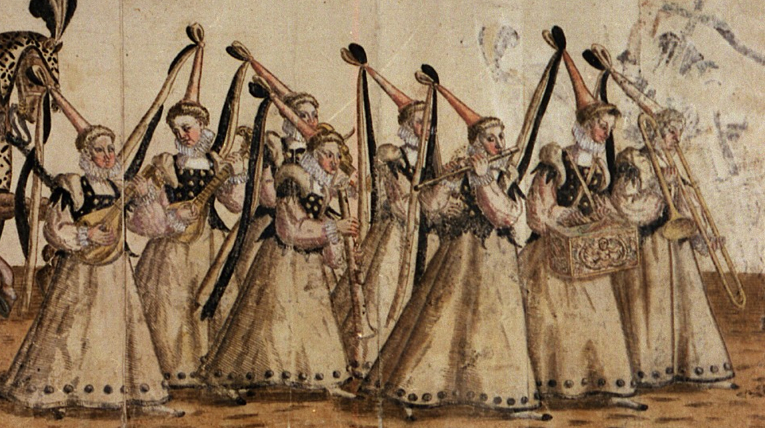
1584—Dresden, Germany: A procession during wedding festivities for Balthasar Wurm and Anton von Sahlhausen (see also entry above) features a group of 8 wind players, including 3 trombones. Close behind them follows an ominous-looking giant with a sickle, hour glass, and infants (see below image—click for larger version; public domain).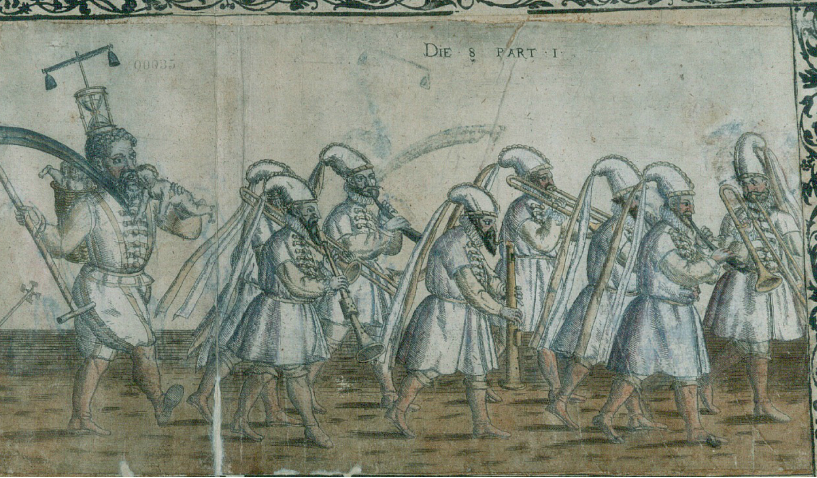
1586-1600—Germany: An image representing musicians in a wedding procession features an ensemble of 3 trombones and 2 cornetts (see facing image; public domain) (graphic arts collection, German National Museum).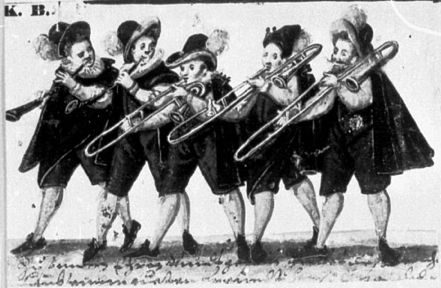
1587—Munich, Germany: Records from the wedding of Pfalzgraf Wolfgang Wilhelm von Neuburg and Magdalena of Bavaria note, “As soon as the princes themselves had arrived, inside the church, up high, one could hear the trombones, trumpets, and timpani on opposite sides. After the congratulations [to the bridal couple] people once again entered the pews and sang the Te Deum Laudamus…” (Bowles, Timpani 366).
1588—France: Thoinot Arbeau mentions the trombone in Orchesography, his treatise on dancing. First, he complains,“Nowadays there is no workman so humble that he does not wish to have hautboys and sackbuts at his wedding” (Arbeau 51). Later, he describes use of the instrument by royalty for dances on solemn feast days: “On solemn feast days the pavan is employed by kings, princes and great noblemen to display themselves in their fine mantles and ceremonial robes. They are accompanied by queens, princesses and great ladies, the long trains of their dresses loosened and sweeping behind them, sometimes borne by damsels. And it is the said pavans, played by hautboys and sackbuts, that announce the grand ball and are arranged to last until the dancers have circled the hall two or three times, unless they prefer to dance it by advancing and retreating. Pavans are also used in masquerades to herald the entrance of the gods and goddesses in their triumphal chariots or emperors and kings in full majesty” (Arbeau 59).
1588—Florence, Italy: At the wedding festivities for Grand Duke Ferdinand III de’ Medici and Christine of Lorraine, the wedding entourage proceeds to the Church of Santa Maria del Fiore, where it is accompanied by “music of trombones and cornetts, which [came] from the middle portal” (Bowles, Musical Ensembles 117).
1598—Hechingen, Germany: Celebrations for the wedding of Count Johann Georg von Hohenzollern and Franziska von Wild- und Rhein feature a lengthy procession that includes an ensemble of cornett, shawm, and trombone players (Bowles, Musical Ensembles 143).
c. 1600—Fackeltanz bei Fürstenhochzeit, an anonymous image, possibly from Germany, depicts a torch dance at a prince’s wedding. Instrumentalists supplying the dance music from a balcony include a tombonist (see below image; click on picture for larger version; public domain) (Salmen, Tanz im 17 153).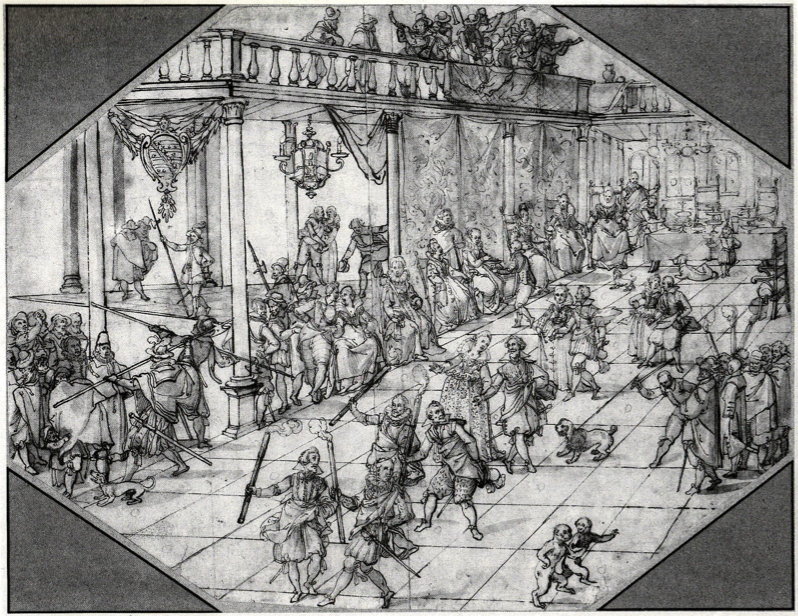
1607—England: Lord Hay commissions a masque at Whitehall by Thomas Campion to celebrate Lord Hay’s marriage. Present at the performance is King James I. The masque features several consorts, including a 10-member group with a double sackbut (double Sack-bott) (Long Study 47; Spitzer 46).
1608—Florence, Italy: Il tempio della Pace, an intermedio by Buonarroti that makes use of polychoral techniques, written for the wedding of Cosimo de’ Medici to Archduchess Maria Magdalena, includes multiple trombones (Carter, A Florentine Wedding).
1609—Stuttgart, Germany: At the wedding celebrations of Archduke Johann Friedrich of Württemberg-Teck and Markgräfin Barbara Sophia of Brandenburg, a trio of trombone, cornetto, and bombard is featured in the Entourage of Young Court Noblemen (see below image; public domain) (Bowles, Musical Ensembles 177). In a separate performance, “As soon as the noble party had arrived at the [court] chapel, there could be heard the trombones, trumpets and kettledrums [along] with two choruses placed opposite each other” (Bowles, Timpani 370). Also in connection with the celebrations, according to records of the time, “There was a completely glorious musical performance, with 20 voices and five ensembles with all kinds of instruments, such as lutes, fiddles, bassoons, dulzians, cornetts, trombones and others” (Bowles, Musical Ensembles 167).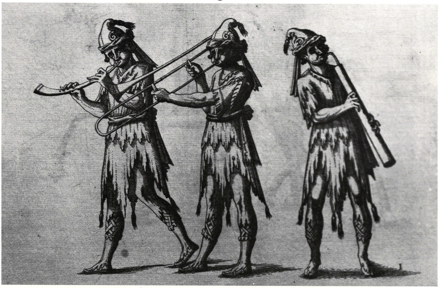
c. 1610—Wedding at Cana, a painting by Flemish artist Frans Francken II (1581-1642) depicts musicians playing trombone, bass viol, viola da braccio, lute, and cornetto (see below image; public domain) (French National Library).
1613—Munich, Germany: At the wedding of Duke Wolfgang Wilhelm of Bavaria to Countess Magdalena of the Pfalz, the wedding party goes to the Frauenkirche, where, according to one report, “Throughout the church, high up, trombones, trumpets and kettledrums were heard” (Bowles, Music in Court Festivals of State).
1617—Stuttgart, Germany: A festival book with engravings by Esaias von Hulsen, published in 1618, portrays the Stuttgart festivals of 1617 surrounding the christening of Ulrich of Württemberg and the marriage of Ludwig Friedrich of Württemberg to Elisabeth Magdalena of Hesse-Darmstadt. It features two different plates in the procession that include 4 different trombonists, all of them apparently female players (see below 2 images; click on image for larger version; public domain) (sources: Komma 128, Festkultur online).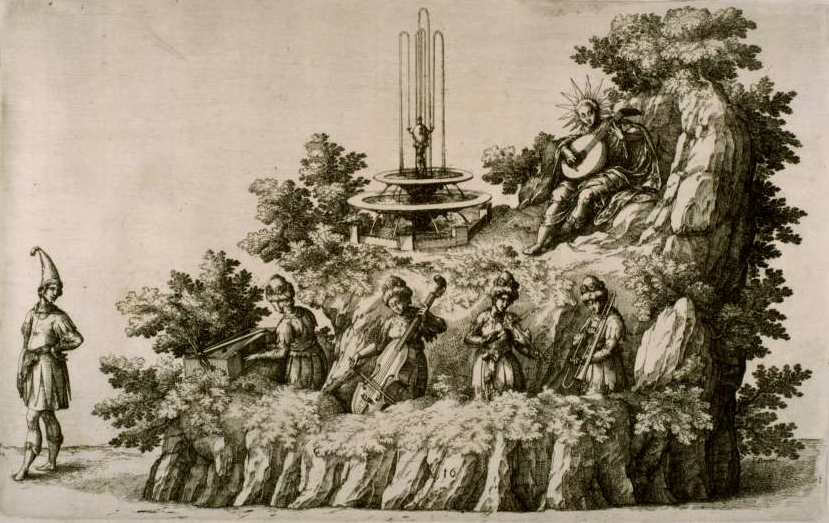
1618—Leipzig, Germany: Heinrich Schütz (1585-1672) includes trombones in the Concert mit 11 Stimmen, which he composes for the wedding of Michael Thomes and Anna Schules (Collver 167).
1618—Bremen, Germany: An anonymous oil painting depicts a wedding procession led by 4 town musicians—alto, tenor, and bass trombones with cornett (instrument identification according to Walter Salmen). The wedding party is apparently wealthy and the musicians are elegantly dressed. The painting is set against the backdrop of the Hanseatic town of Bremen (Salmen, Status).
c. 1625—Lübeck, Germany: As part of the city’s extensive ordinances for musicians, weddings are allowed to include processions to and from the church, accompanied by trombones decorated with banners (Buelow, Protestant 203).
1636—France: Mersenne, describing the shawm band, explains that it is used for large assemblies, such as ballets (though violins have replaced shawms there), weddings, village festivals, and other public celebrations. His musical example includes 2 treble shawms, 2 tenor shawms (or alt pommern), sackbut, and bass.
1650—Turin, Italy: Marriage festivities for Princess Adelaide of Savoy and Prince Ferdinand Maria of Bavaria include trombones. First, on the way to the Cathedral of San Giovanni for the service itself, “Swiss Guards and arquebusiers of Their Majesties…lent their presence to the retinue setting out for the cathedral from the great hall of the palace [along] with trumpets, trombones, oboes and drums.” After the wedding service there are “signals by trumpets and trombones to those present who, because of the huge crowd, couldn’t observe the nuptials.” Later, during a series of races in the palace courtyard, races alternate with musical performances by musicians in a gallery (see below image, an engraving by Tomasso Borgonio titled Gli Hercoli domatori; public domain): “From the other palace, above the gallery, among the various events alternating with the races was the reverberation of the sound of an ensemble of instruments; that is, trumpets which, animated by the virtue of such glorious love [of the newlyweds] became the voices of Fame; trombones, which, with harmonious notes echoed the praises of everyone, rousing more ardently by the hour the affections…” (Bowles 275-279; Tim Carter, North Italian 42).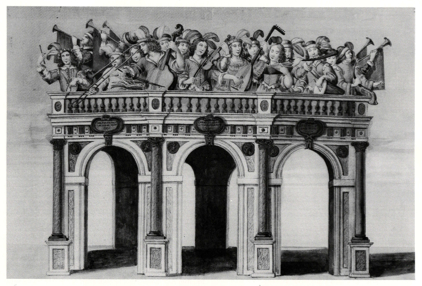
1662—Oslo, Norway: Reverend Christen Staffensön Bang writes “In our Lutheran churches a goodly number of musical instruments are used, especially on major holidays and whenever people of the upper class hold their wedding service. On these occasions instrumental music is played using organ, trumpets, trombones, zithers, violins, etc. And in this way singers and instrumentalists alike join together in praising and serving God as best they can” (Grinde 44).
1670—Danzig: A contemporary description of wedding festivities describes music played from the tower of the town hall: “with the drums which first played on their own for a while, after which the trumpets joined in, and then the trombones (posaunen), Storten and cornetts” (Boydell, Crumhorn 135).
1671—Altenberg, Germany: The court trumpeters (Kammeradschaft) lodge a complaint against the trombonists and other civic musicians for imitating the sound of the trumpet on their instruments. The city fathers, in turn, defend the civic players thus: “[The civic players] used their instruments, such as trombones, cornetts, also violins [and] viola, according to the music, as well as they could in all places for celebrations, weddings, and other honorable gatherings. It is also customary everywhere that they perform, from the music set down, on the instruments discussed here, and if town’s people and other music lovers requested a tune in the manner of trumpets on trombones, cornetts and violins, they could not help but oblige them as best they could in this way. All of which has been customary here and in other places according to their art for countless years” (Collins).
1681—Genoa, Italy: Alessandro Stradella composes Inventione per un barcheggio for the wedding celebrations of Signori Carlo Spinola and Paula Brignole, members of two noble families. In the work, trombone is specified as part of the continuo. Precise instructions include the following: “All the basses with one trombone, but the trombone must play very staccato and with little breath.” The performance, as described by a chronicler of the time, takes place on the water: “Towards the evening on Thursday the ladies and gentlemen of this city had a sumptuous diversion on the bay, having been taken round the harbour by four galleys, besides a very great number of smaller boats, and then conducted aboard an apparatus [made] of barges, [which] formed a hall covered by light-weight silk and richly adorned. Here they were entertained with an interweaving of harmonious voices, poetry and instrumental music accompanied by the most exquisite food and refreshments of all sorts…” (Gianturco).
1708—Barcelona, Spain: At the marriage of Archduke Charles VI of Austria to Princess Elizabeth of Brunswick-Wolfenbüttel, celebrated in Barcelona, “A Te Deum laudamus, composed by J[ohann] J[oseph] Fux, was sung ‘with the sweetest harmonies’ for two sopranos, alto, tenor, bass and an instrumental ensemble consisting of two violins, three violas, two trumpets, two trombones and timpani” (Bowles, Timpani 415).
c. 1855—Artist Albert Kindler includes a trombonist in his painting After the Wedding. The trombonist stands in the musicians’ boat in the background (see detail and full image below; public domain).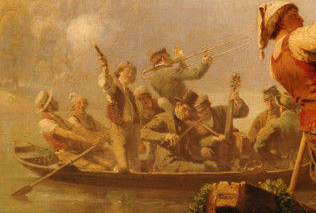

c. 1860—Peru: Artist Pancho Fierro depicts a trombonist performing with a wind band for a Peruvian wedding celebration in Fiesta de Matrimonio (see detail and full image below; public domain) (Lavalle 38).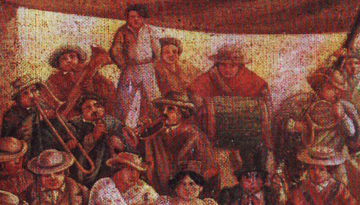
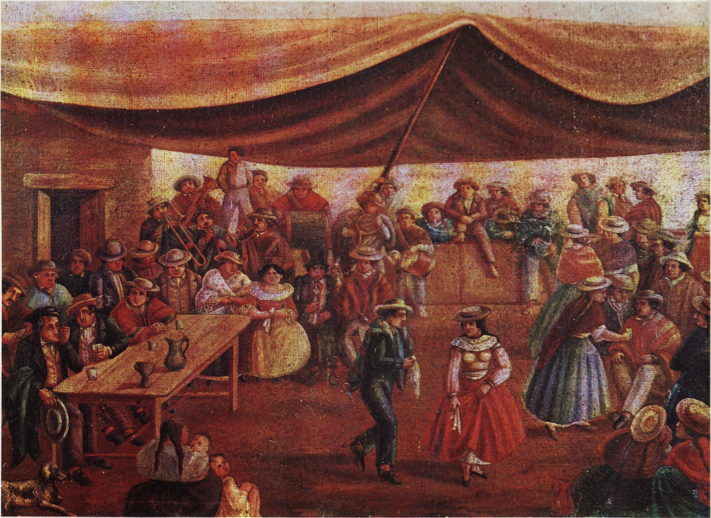
1873—Italy: Angelo Inganni’s painting, Festa di nozze in un cortile (Wedding Party in a Courtyard) includes a trombone playing with a small ensemble (see detail and full image below; public domain) (Trieste, Civico Museo Revoltella).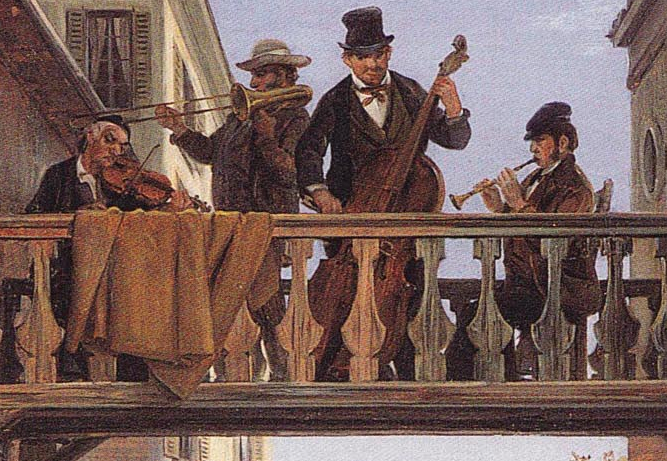
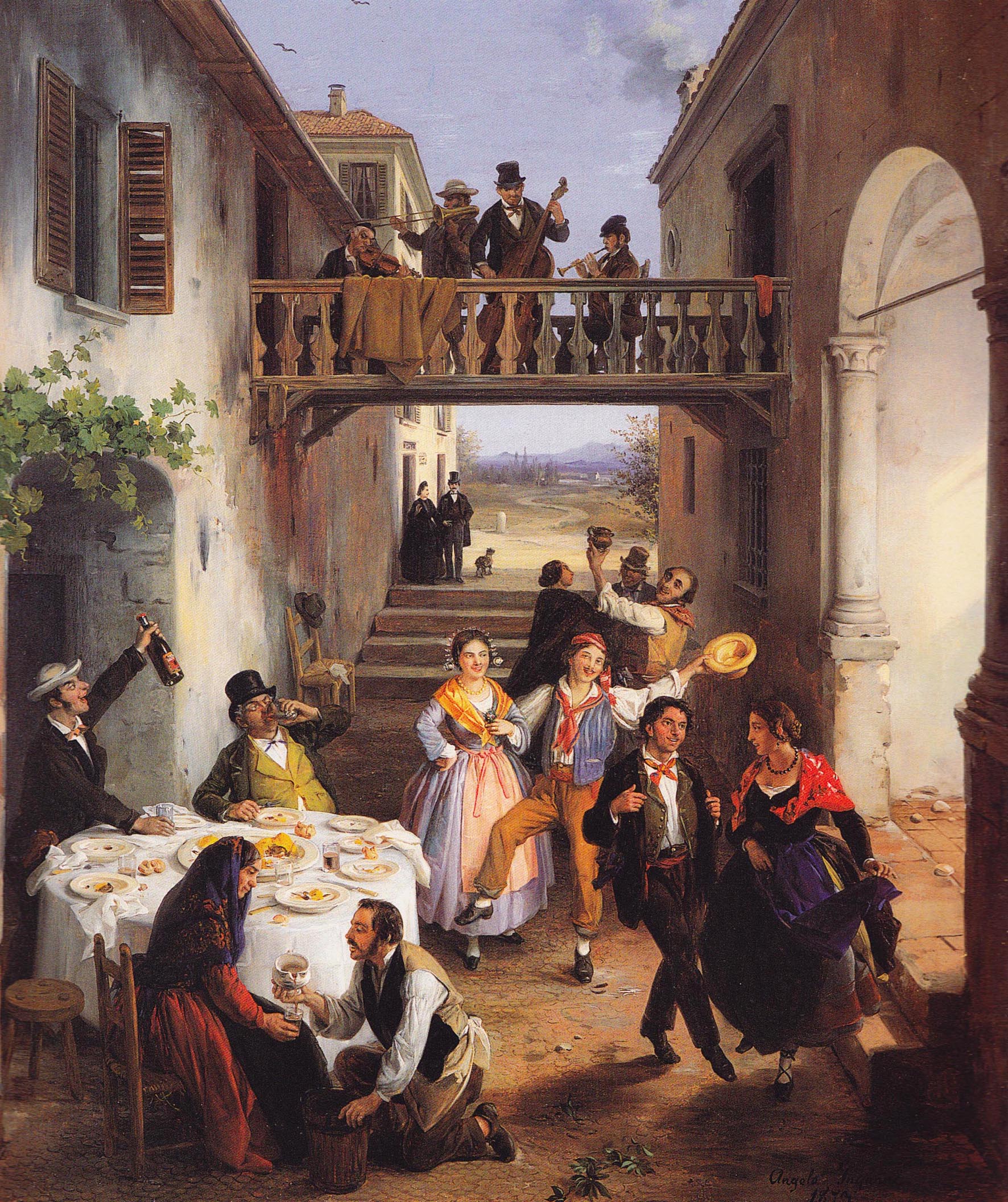
c. 1878—Benjamin Vautier’s painting, Dancing Break at an Alsatian Wedding, features a small group of musicians, including a trombonist apparently emptying the water out of his horn (see below image; public domain). Click image to expand.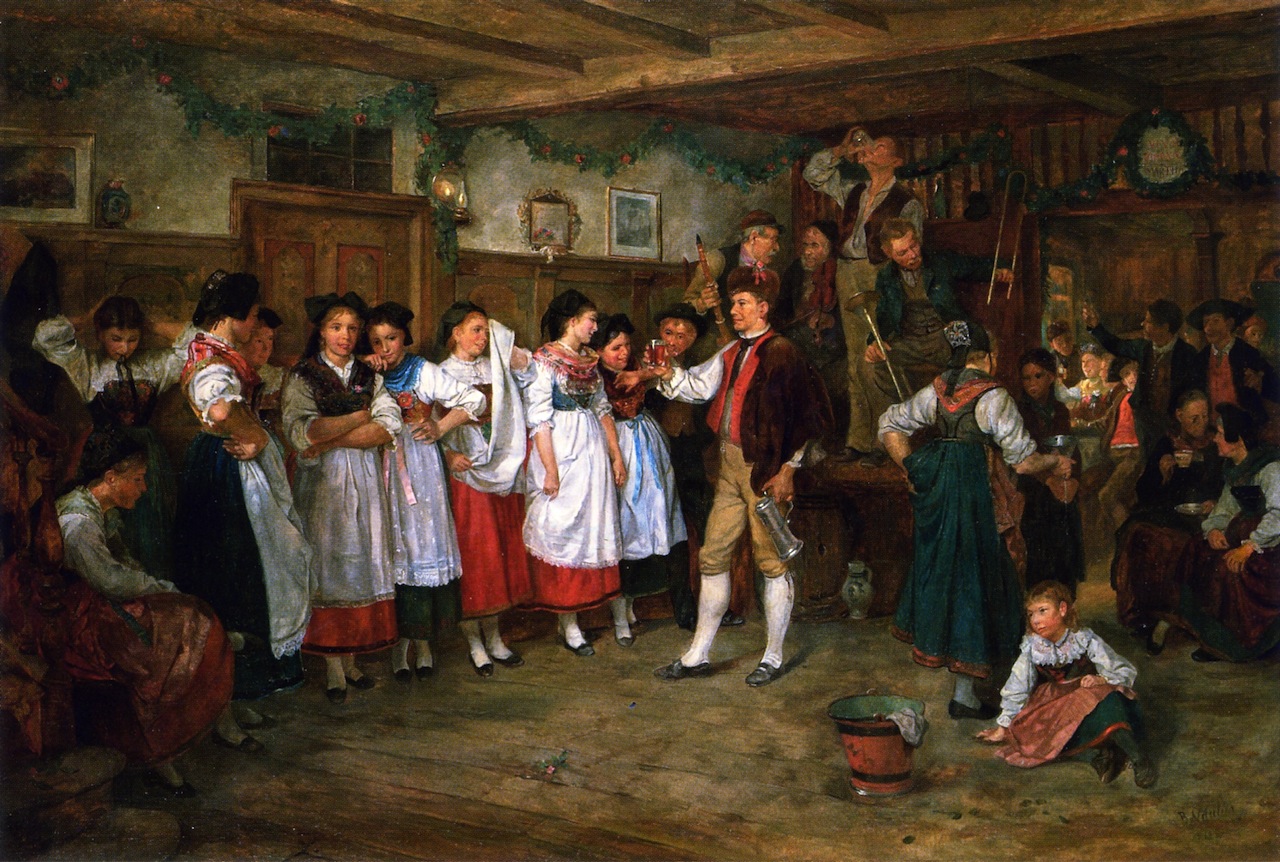
c. 1890—Italy: Antonio Lonza’s painting, Newly Married Couple, includes a trombonist as part of an ensemble performing outdoors for a wedding celebration. The trombone appears to have a double slide (see below image, after Lonza painting; public domain) (Seidl, vol. 2, 325).